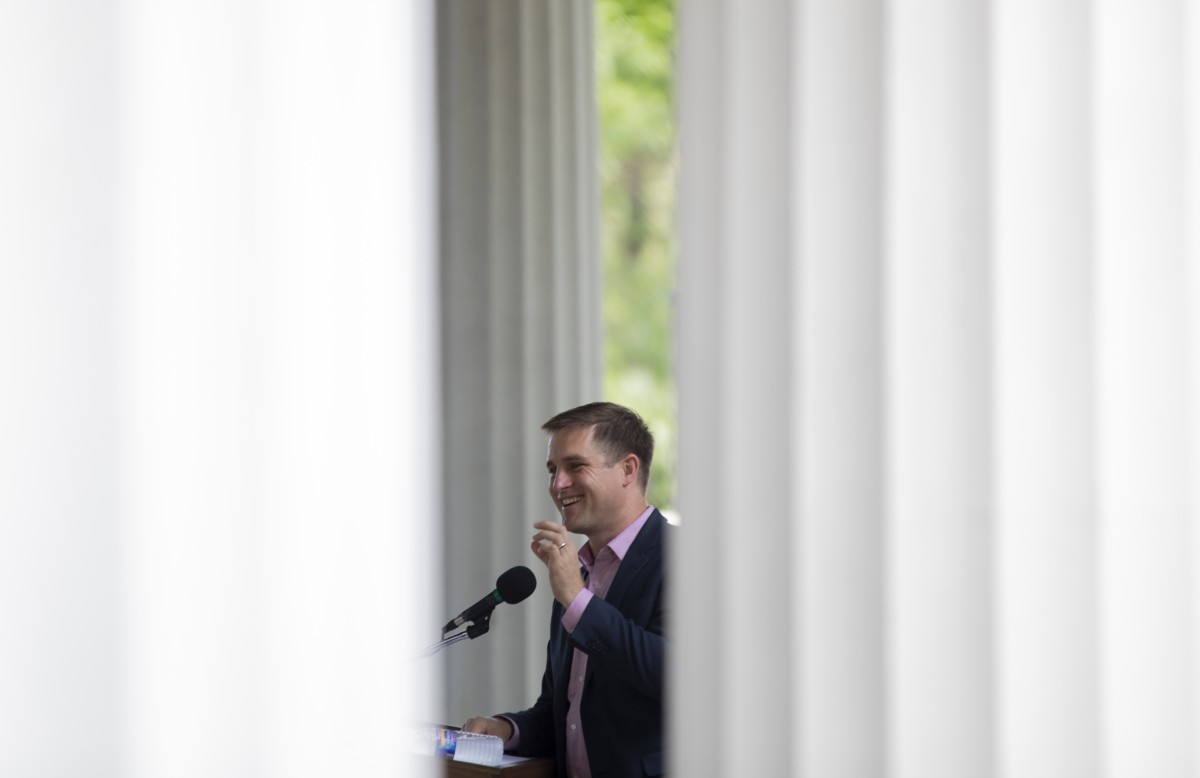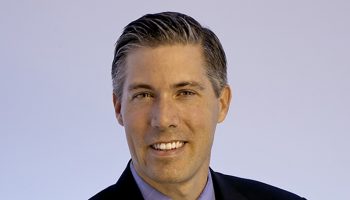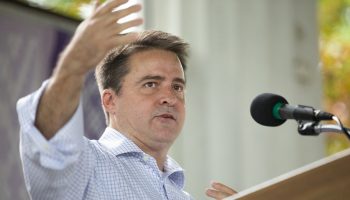America is going through a tumultuous period in which religion, society and politics interact in ways that leave all three decisively transformed. Many historians refer to these periods as “great awakenings,” but historian and documentary editor Spencer McBride refers to these great awakenings as identity crises.
At 2 p.m. on Wednesday, July 4, in the Hall of Philosophy, McBride gave his lecture, “Religious Awakenings and America’s National Identity Crisis,” as part of Week Two’s interfaith theme, “Religion and American Identity.” McBride’s lecture was moderated by Interfaith Youth Core Founder Eboo Patel. Patel, who is moderating all of the Week Two interfaith lectures, is an advocate for religious tolerance and wrote a set of essays on religious pluralism that will be published in the fall by Princeton University Press.
The reason McBride refers to this moment as a crisis is because he believes any attempt to define what American identity is is exclusionary to some degree.
“Part of what we do when we say what type of country we are, is inherently say what kind of country we are not,” McBride said.
But this confusion is nothing new. To contextualize his argument, McBride began by going back to the beginning of another crisis that started between the years of 1800 to 1850,also known as the Second Great Awakening.
The Second Great Awakening was a period in American history when a wave of religious enthusiasm spread across the country. This led to a rapid rise in church membership and religious participation, which benefited Christian churches of all denominations, but two benefited more than the rest: the Baptists and Methodists, who McBride said gained the largest number of converts.
“This is interesting because now in America, the Baptists and the Methodists seem very much part of mainstream Christianity, but that was not always the case,” he said.
During the time periods before, during, and after the Revolutionary War, there were Baptists and Methodists, but they were Protestant off-shoots and were treated differently than other Americans. Members of these denominations could not participate in things such as holding public office or voting until the ratification of the Constitution in 1788. This caused many debates among members of other branches of Christianity, and some even opposed the Constitution because of it.
During this time, evangelical Christians were on the opposite side of the movement as the most staunch advocates for a complete separation between church and state.
“This seems foreign to our sensibilities in today’s political culture, but back then, the people who were being hurt the most were these evangelical communities,” McBride said. “They were the ones being persecuted and discriminated against by their governments.”
However, this changed in the late 1820s as Andrew Jackson and Henry Clay faced off in a presidential race. Clay ran against Jackson in a rival party called the Whigs. In 1832, knowing Jackson would veto it, Clay proposed the idea of holding a day of fasting and prayer, anticipating that Jackson’s veto would drive the evangelicals to vote for the Whigs. It worked, and this is where McBride said evangelical Christians saw their greatest shift in belief.
“The rise of these younger religious denominations affected how we thought about ourselves as Americans,” he said. “It moved this group that had once been very much opposed to the integration of church and state, to push for state being involved in moral and religious issues.”
The cause of this phase of the Second Great Awakening is a series of “revival meetings” happening across the United States. The goal of these meetings was to either commit, or lead others to commit, to an ardent faith in Jesus Christ, McBride said.
“The preachers would preach in a manner that was designed to elicit a response of sincere faith,” he said. “In their minds, the best reaction that could happen is people would feel the emotional desire to accept Jesus as their savior, they would confess and forsake their sins, and then they would commit to actively participate with one of the many churches competing for their membership.”
Although these meetings were initially successful, McBride said, they failed in the long run.
“The problem with this was that the preachers were less concerned with what denomination you adhered to and more concerned that they convince you to join the Christian Church,” he said. “This caused people to become initially enthralled in their newfound faith, but fade out as time went on.”
McBride believes it is no coincidence that the Second Great Awakening happened when it did.
For one, it was a reaction to the Revolutionary Era because religious skepticism and deism, the belief that God created the world and then ceased to interfere in the affairs of mankind, were on the rise.
“There were Americans who believed the country’s religious culture was lacking a strong emotional component, that there needed to be something that compelled men and women to a deeper Christian conversion,” Mc- Bride said.
In addition to this reactionary element,many saw this great awakening as an outgrowth of the democratization of American society, McBride said.
“In a country where men could seemingly move geographically, socially and economically with greater ease than ever before, these Americans would naturally seek and create religious communities that better met their personal needs,” he said.
This led to a rise in “ordinary men” — men who had never set foot in a seminary or divinity school — to assume positions as ministers or preachers in one faith or a faith of their own creation.
“As Christianity became increasingly important to more Americans, more Americans began to increasingly see Christianity as important to the country,” McBride said. “They began to view their politics and their country’s history through a lens of Christian devotion.”
Ultimately, McBride believes in order to understand why so many Americans were attracted to these religious movements, one has to look into the recurring theme of feeling discontent.
“There were thousands of Americans who were discontent with the status quo, so they chose to do something different,” he said. “That means something.”
This is why participants of this Second Great Awakening took a lead role in many of the reform movements of 19th-century America, including the abolishment of slavery, the temperance movement and women’s suffrage.
However, religion had a role in both the support and the opposition of these movements, a complexity McBride said has stayed with Americans to present day.
“Some Americans celebrated their right to worship according to the dictates of their own conscience and allowed others to do the same,” he said. “But at the same time, there were other Christian Americans who used their religious beliefs to justify discriminating against people who believed something too different than what they were ready to accept. They tried to disguise this as democracy.”
McBride is still unsure about a solution to this problem, but what he does know is that education and dialogue are key to reducing the severity of it.
“If we can talk about it that way and get others to talk about it, I think it will be a huge step toward peace and equality and universal religious liberty in our democratic society,” he said. “The historian in me tells me we can change. If we can all understand how the world came to be the way that it is, we can make it the way it needs to be.”






